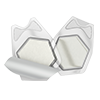- OVERVIEW
- PRODUCTS
- Casting & Splinting
- Hand Hygiene
- Patient Monitoring
- Securement and Immobilization
- Skin Care
- Wound Care
- Sterilization & Monitoring
- Surgical Solutions
- Vascular Access
- View all
- CONDITIONS
- Bloodstream Infections
- Incision Management
- Surgical Site Infections
- Incontinence-Associated Dermatitis
- Pressure Injury Prevention
- Wound Care
- EDUCATION
- SUPPORT

Pressure Injury Prevention and Wound Management
Advanced solutions for pressure injury prevention and wound management
-
Pressure injuries (PI) can lead to longer hospital stays, higher rates of readmission, greater pain and suffering for the patient, and in some cases even premature mortality.1 Learn more about global best practices and how 3M’s breadth of science-backed solutions for skin protection and advanced wound care can help you prevent and treat pressure injuries.
-

More than 2.5M people in the U.S. develop pressure injuries annually²
-

12K-40K USD per pressure injury (on average, one pressure injury costs 10,700 USD)³
-

Pressure injuries add 3-7 days to patient stays⁴
-

Total wound-related costs for pressure ulcer patients were 70% lower for those treated early with 3M™ V.A.C.® Therapy vs. late*,5
-
*In a retrospective study of 372 chronic pressure injury patients with a Skilled Nursing Facility stay, early Negative Pressure Wound Therapy initiation resulted in lower wound-related costs than late use of NPWT, supporting previous published benefits of early initiation of NPWT. Each patient received at least 1 charge for NPWT HCPCS code (E2402). Includes patients on V.A.C. Therapy only.
Thank You
Your form was submitted successfully. A 3M representative will contact you shortly.
Our Apologies...
An error has occurred while submitting. Please try again later...

It can mean your patients getting back to life, which is why it means so much to us. From foam dressings and polymer-based skin protectants, to Negative Pressure Wound Therapy (NPWT), each 3M solution for your PI prevention and wound management program is designed to help address the complexities of PIs across care settings.
Start transforming clinical and economic outcomes for your patients today with clinically backed solutions from 3M.
-
Solutions for Your Care Setting
3M understands each type of care setting faces unique challenges. Learn more about how 3M’s pressure injury prevention and wound management solutions impact your facility’s needs.
Our apologies...
An error has occurred while submitting. Please try again later...
Thank you!
Your form was submitted successfully
-
References:
1. Health Research & Educational Trust (2016, January). Hospital Acquired Pressure Ulcers (HAPU) Change Package: 2016 Update. Chicago, IL: Health Research & Educational Trust. Accessed at www.hret-hen.org.
2. AHRQ National Scorecard on Hospital-Acquired Conditions Updated Baseline Rates and Preliminary Results 2014–2017. Adrq.gov. https://www.ahrq. gov/sites/ default/files/wysiwyg/ professionals/quality-patient-safety/pfp/ hacreport-2019.pdf. Published January 2019. Accessed July 1, 2019.
3. Asmus R, Bodkhe R, Ekholm B, Thayer D, and Bradley J. The Effect of a High Endurance Polymeric Skin Protectant on Friction and Shear Stress. Poster presentation at the2018 Symposium on Advanced Wound Care Las Vegas NV and 2019 National Pressure Ulcer Advisory Panel Annual Conference St Louis MO.
4. Coyer, F., Gardner, A., & Doubrovsky, A. (2017). An interventional skin care protocol (InSPiRE) to reduce incontinence-associated dermatitis in critically ill patients in theintensive care unit: A before and after study. Intensive and Critical Care Nursing, 40, 1-10.
5. .Law A. Economic value with V.A.C.® Therapy: Effect of early versus late initiation of negative pressure wound therapy on total treatment and wound-related costs. Analysis conducted on insurance claims data by Axia Ltd. 2015.
6. European Pressure Ulcer Advisory Panel, National Pressure Injury Advisory Panel and Pan Pacific Pressure Injury Alliance. Prevention and Treatment of Pressure Ulcers/Injuries: Quick Reference Guide. Emily Haesler (Ed.).EPUAP/NPIAP/PPPIA:2019
7. National Pressure Injury Advisory Panel. 2014 Guidelines. Prevention and Treatment of Pressure Ulcers: A Clinical Guide. Accessed at http://www.internationalguideline.com/static/pdfs/NPUAP-EPUAP-PPPIA-CPG-2017.pdf.
8. Demarre L et al. (2015). Factors predicting the development of pressure ulcers in an at-risk population who receive standardized preventive care: secondary analyses of a multicentre randomised controlled trial. J Adv Nurs., 71(2):391-403.
9. 3M data on file. LAB-05-385368.
10. 3M data on file. EM-05-291517.
















